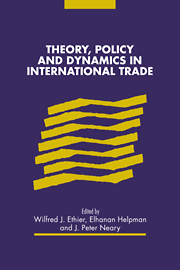Book contents
- Frontmatter
- Contents
- List of conference participants
- I Introduction
- II History, geography and the theory of trade
- III The structure of simple trade models
- IV Policy towards international trade
- V Trade, growth and dynamics
- 11 Prices of goods and factors in a dynamic stochastic economy
- 12 Capital market imperfections and the infant industry argument for protection
- 13 Endogenous real business cycles and international Specialization
- 14 Impact of government on growth and trade
- 15 Long-run production frontiers for the Jones specific-factors model with optimal capital accumulation
- 16 Hysteresis in the trade pattern
- Index
15 - Long-run production frontiers for the Jones specific-factors model with optimal capital accumulation
Published online by Cambridge University Press: 16 March 2010
- Frontmatter
- Contents
- List of conference participants
- I Introduction
- II History, geography and the theory of trade
- III The structure of simple trade models
- IV Policy towards international trade
- V Trade, growth and dynamics
- 11 Prices of goods and factors in a dynamic stochastic economy
- 12 Capital market imperfections and the infant industry argument for protection
- 13 Endogenous real business cycles and international Specialization
- 14 Impact of government on growth and trade
- 15 Long-run production frontiers for the Jones specific-factors model with optimal capital accumulation
- 16 Hysteresis in the trade pattern
- Index
Summary
Introduction
For those of us who received our classroom instruction in international trade theory prior to 1971, the 2 × 2 Heckscher-Ohlin model of trade constituted our “basic training.” The two-good, two-factor model with both factors perfectly mobile between the two sectors was the simple general-equilibrium model of factor proportions trade (simple one-factor Ricardian models constituted a technology-based explanation of trade). It is not clear what the justification for this exclusive focus was, but it is certainly true that the four theorems derived from that model constitute an elegant statement of theory: the Heckscher–Ohlin theorem, the factorprice- equalization theorem, the Rybczynski theorem, and the Stolper- Samuelson theorem.
In 1971, Ronald Jones published his paper, “A Three Factor Model in Theory, Trade, and History,” in which two goods are produced with three factors, two of which are sector specific and one of which is mobile between sectors. Jones expressed several motivations for this model. First, it removed the “straightjacket” of factor-price equalization, in that factor prices now depend on factor supplies as well as on commodity prices. Second, Jones found the model consistent with recent articles (at the time) in economic history and the theory of capital and international trade.
Gradually, the Jones specific-factors model has become more and more popular, both for pedagogic and for research purposes. The model in my opinion is now used at least as often as the Heckscher–Ohlin model to teach the simple general-equilibrium theory of trade. Several reasons for this popularity are found in later papers by Mayer (1974), Mussa (1974), and Neary (1978).
- Type
- Chapter
- Information
- Theory, Policy and Dynamics in International Trade , pp. 252 - 267Publisher: Cambridge University PressPrint publication year: 1993



